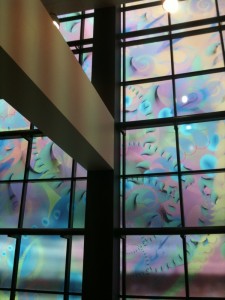
Galápagos++, 2009
Argonne National Laboratory, Theory and Computing Sciences Building, IL
A collaboration with Michael E. Papka.
Galápagos++ is a 40-foot by 40-foot translucent computer-generated artwork installed at the Theory and Computing Sciences building of Argonne National Laboratory. It covers the TCS building library’s south window. The piece intermingles visual elements inspired by biology, physics, and mathematics to create an organic cosmology evocative of the sea of ideas into which science dips.
The image itself is generated by a stochastic, context-free grammar. The grammar is a set of rules that defines and confines the spatial and spectral relationships between the graphical elements of the image. Writing and tuning this grammar is part of the work of “painting” the image. From this grammar, a large number of expressive instances are possible; each a kind of sentence allowed by the grammar. Galápagos++ is one such sentence.
Galápagos++ owes aspects of its look and feel to the relationship TCS has to Waterfall Glen. The Glen as proxy for all of nature is filtered through the scientific body of thought embodied in the workings of the facility and projected onto the screen of the library window. The name Galápagos++, pronounced “Galápagos plus plus”, refers to the famed islands which served as the inspiration for Darwin’s sweeping theory of evolution. The small appendage to the name invokes the postfix increment operator common to many computer-programming languages and indicates an incremental step forward.
Acknowledgments:
Galápagos++ was created by Mark Hereld and Michael E. Papka. Credit for the idea of creating a “stained glass” fractal and the impetus for the project goes to Rick L. Stevens and Joseph Lambke. The artists acknowledge the developers of Context Free — the interpreter that generated the image from the grammar — and Pete Beckman for bringing Context Free to their attention.